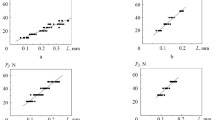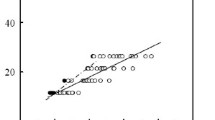Methodical aspects of experimental investigation of brittle materials under local edge loading by scratching the specimen surface with a Rockwell indenter to its edge chipping (S+EF method) are detailed. The edge damage parameter range (fracture distance) had its basis in the literature data on numerical simulation of the stress-strain state in the local indentation zone of the material surface to its edge chipping. Fractographic analysis of tested edges revealed their damage behavior under given loading conditions. The paths of fracture crack propagation to the formation of “shell-like” chip scars, which are asymmetric quasi-conical crack traces, are studied. Partially formed or strained chips having a somewhat distorted fracture surface as compared to the “ideal” geometry of the edge chip were also found. The asymmetry of chip scars was established to have no effect on the fracture resistance of the material. The validity of empirical investigation results was achieved with a minimum test scope, determined by statistical data processing. This test method of low material intensity can be effectively applied to different lines of research.



Similar content being viewed by others
References
G. A. Gogotsi, V. I. Galenko, S. P. Mudrik, et al., “Glass fracture in edge flaking,” Strength Mater., 39, No. 6, 639–645 (2007).
V. V. Khvorostyanyi, “Mechanical behavior of ceramics and glass during specimen edge fracture caused by Rockwell indentor,” Strength Mater., 46, No. 3, 383–390 (2014).
CEN/TS 834-9. Advanced Technical Ceramics – Mechanical Properties of Monolithic Ceramics at Room Temperature – Part 9: Method of Test for Edge-Chip Resistance, CEN (2010).
B. A. Lattella, “Scratch damage in porous alumina ceramics,” J. Mater. Sci. Lett., 19, 1127–1130 (2000).
J. A. Williams, “Analytical models of scratch hardness,” Tribol. Int., 29, 675–694 (1996).
L. A. Flanders, J. B. Quinn, O. C. Wilson, Jr., and J. K. Lloyd, “Scratch hardness and chipping of dental ceramics under different environments,” Dental Mater., 19, 716–724 (2003).
G. A. Gogotsi, “Fracture behavior of Mg-PSZ ceramics: Comparative estimates,” Ceram. Int., 35, 2735–2740 (2009).
V. G. Baryakhtar, Physics of Solids Encyclopaedic Dictionary [in Russian], in 2 volumes, Naukova Dumka, Kiev (1996).
G. A. Gogotsi, V. I. Galenko, S. P. Mudrik, et al. “Fracture behaviour of Y-TZP ceramics: New outcomes,” Ceram. Int., 36, 345–350 (2010).
G. A. Gogotsi, V. I. Galenko, S. P. Mudrik, et al., “Fracture resistance estimation of elastic ceramics in edge flaking: EF baseline,” J. Eur. Ceram. Soc., 30, 1223–1228 (2010).
E. A. Almond and N. J. McCormick, “Constant-geometry edge flaking of brittle materials,” Nature, 321, 53–55 (1986).
R. Morrell and A. J. Gant, “Edge chipping of hard materials,” Int. J. Refract. Met. H., 19, 293–301 (2001).
N. J. McCormick and E. A. Almond, “Edge flaking of brittle materials,” J. Hard Mater., 1, 25–51 (1990).
A. Mohajerani and J. K. Spelt, “Edge chipping of borosilicate glass by blunt indentation,” Mech. Mater., 42, 1064–1080 (2010).
G. A. Gogotsi and S. P. Mudrik, “Glasses: New approach to fracture behavior analysis,” J. Non-Cryst. Solids, 356, 1021–1026 (2010).
H. Chai and B. Lawn, “A universal relation for edge chipping from sharp contacts in brittle materials: A simple means of toughness evaluation,” Acta Mater., 55, 2555–2561 (2007).
F. Petit, V. Vandeneede, and F. Cambier, “Ceramic toughness assessment through edge chipping measurements – Influence of interfacial friction,” J. Eur. Ceram. Soc., 29, 2135–2141 (2009).
G. D. Quinn, “Edge chip testing of ceramics,” J. Am. Ceram. Soc. Bull., 92, 24–28 (2013).
O. A. Batanova, G. A. Gogotsi, and Yu. G. Matvienko, “Numerical modeling edge chipping tests of ceramics,” Eng. Fract. Mech., 132, 38–46 (2014).
O. A. Batanova, G. A. Gogotsi, and Yu. G. Matvienko, “Numerical analysis of experimental results for specimen edge chipping,” Zavod Lab. Diagn. Mater., No. 7, 53–56 (2011).
M. N. Stepnov, Statistical Processing Methods for Mechanical Test Results. Handbook [in Russian], Mashinostroenie, Moscow (1985).
Author information
Authors and Affiliations
Corresponding author
Additional information
Translated from Problemy Prochnosti, No. 5, pp. 65 – 73, September – October, 2020.
Rights and permissions
About this article
Cite this article
Khvorostyanyi, V.V. Fracture Resistance of Brittle Materials Under Local Loading by Scratching to Edge Chipping. Part. 1. Methodical Grounds of Research. Strength Mater 52, 746–752 (2020). https://doi.org/10.1007/s11223-020-00228-0
Received:
Published:
Issue Date:
DOI: https://doi.org/10.1007/s11223-020-00228-0




